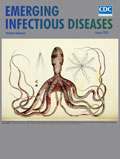
Volume 26, Number 8—August 2020
CME ACTIVITY - Research
Sporadic Creutzfeldt-Jakob Disease among Physicians, Germany, 1993–2018
Peter Hermann1 , Johannes Treig1, Steffen Unkel, Stefan Goebel, Timothy Bunck, Martha Jünemann, Tim Friede, and Inga Zerr
, Johannes Treig1, Steffen Unkel, Stefan Goebel, Timothy Bunck, Martha Jünemann, Tim Friede, and Inga Zerr
Abstract
We investigated sporadic Creutzfeldt-Jakob disease (sCJD) among physicians in Germany by analyzing occupational information of patients with sCJD recorded by the German CJD Surveillance Unit (1993–2005; 1,250 patients, of whom 4 [0.32%] were physicians) and the National Reference Center for Human Spongiform Encephalopathies (2006–2016; 1,491 patients, of whom 13 [0.87%] were physicians). Among the physicians, we did not identify any neurologists, neurosurgeons, psychiatrists, or pathologists. A cumulative sum test showed an increase in reported physicians over time. Data for 2017–2018 indicated an increased rate of physicians among all notified sCJD cases (5/239 [2.1%]) when we used the total population of Germany as control group. Our data suggest the possibility of an increased risk for sCJD among physicians in Germany. However, we can only speculate about the reasons, and larger multinational studies are needed to replicate the finding and to clarify whether this finding is a general or a country-specific phenomenon.
Creutzfeldt-Jakob disease (CJD) is a syndrome comprising dementia and various neurologic signs and symptoms (1) caused by the transmissible misfolded prion protein scrapie (2). Reported death rates and incidence rates differ from 1.67 (3) to >2 per million person-years (4,5). In contrast to animal prion diseases (6,7), transmitted human prion diseases are uncommon. Variant CJD (vCJD) caused by ingestion of beef is rare (231 cases worldwide) (8), and its incidence has decreased since 2000 (9). Most cases of human prion disease are sporadic CJD (sCJD; 84%–93%), followed by genetic CJD (5%–10%). Only <4% are considered to be iatrogenic (iCJD) (3,10–12). Clinical diagnostic criteria of iCJD imply the presence of an iatrogenic risk factor (13). Known cases were caused by cadaver-derived growth hormones, dura mater grafts, neurosurgical instrument contamination, and corneal grafts (12). On the other hand, iCJD might be overlooked when no classic risk factor is present. Neuropathologic characteristics can identify iCJD only in a subgroup of cases (14,15). Unrecorded cases related to surgery are likely because an increased risk for sCJD in persons with a history of surgery was reported (16); however, data on this issue remain ambiguous (17). vCJD transmitted by transfusion of blood products has been reported (8), but no confirmed case was recorded among recipients of blood from donors with sCJD (18–20).
An increased risk for iCJD among caregivers and healthcare professionals has been suggested, but its evaluation is complex (21–24). Previous studies neither unequivocally displayed nor ruled out relevant increases in risk for CJD among healthcare professionals (25,26). Furthermore, these investigations were mostly designed as case–control studies, which are prone to bias because of case selection. Therefore, we aimed to evaluate sCJD among physicians using historical epidemiologic data from 25 years of CJD surveillance in Germany and the whole population of that country as controls.






















.png)











No hay comentarios:
Publicar un comentario